Estimated reading time: 16 minutes
Table of contents
- A Gothic and Romanesque Architectural Masterpiece
- Construction of the Duomo di Siena
- Key stages of construction of the Duomo di Siena
- Black and White Marble Walls and Columns of the Duomo
- Exquisitely Inlaid Marble Floors – the Pride of the Duomo di Siena
- The Dome of the Duomo di Siena
- Siena Cathedral’s High Vaulted Ceilings are a Marvel to Behold
- The Magnificent Stained Glass Window of the Siena Duomo
- Works of Art on Display in the Siena Cathedral
- The Crypt of the Duomo di Siena
- The Piccolomini Library
- Duomo Tickets, Passes and Wait Times
- Author’s note:
- Where to Find the Duomo di Siena
A Gothic and Romanesque Architectural Masterpiece
While in Siena, we spent a couple of days exploring the Duomo di Siena, also known the Siena Cathedral or Cathedral of Santa Maria Assunta. It is a stunning example of Italian Gothic and Romanesque architecture and a must-see for anyone visiting the city of Siena. Experts consider it to be one of the most beautiful churches in all of Italy.
This magnificent cathedral is dedicated to Assumption of Mary and is part of the Siena Historic Center UNESCO World Heritage Site. The Duomo is perched atop the highest point in Siena and its distinctive black and white structure dominates the Sienese skyline. It is clearly visible from the Tuscan countryside as you approach the city. The Cathedral was one of the highlights of our seven days in Siena and dare I say, of our entire road trip in Italy
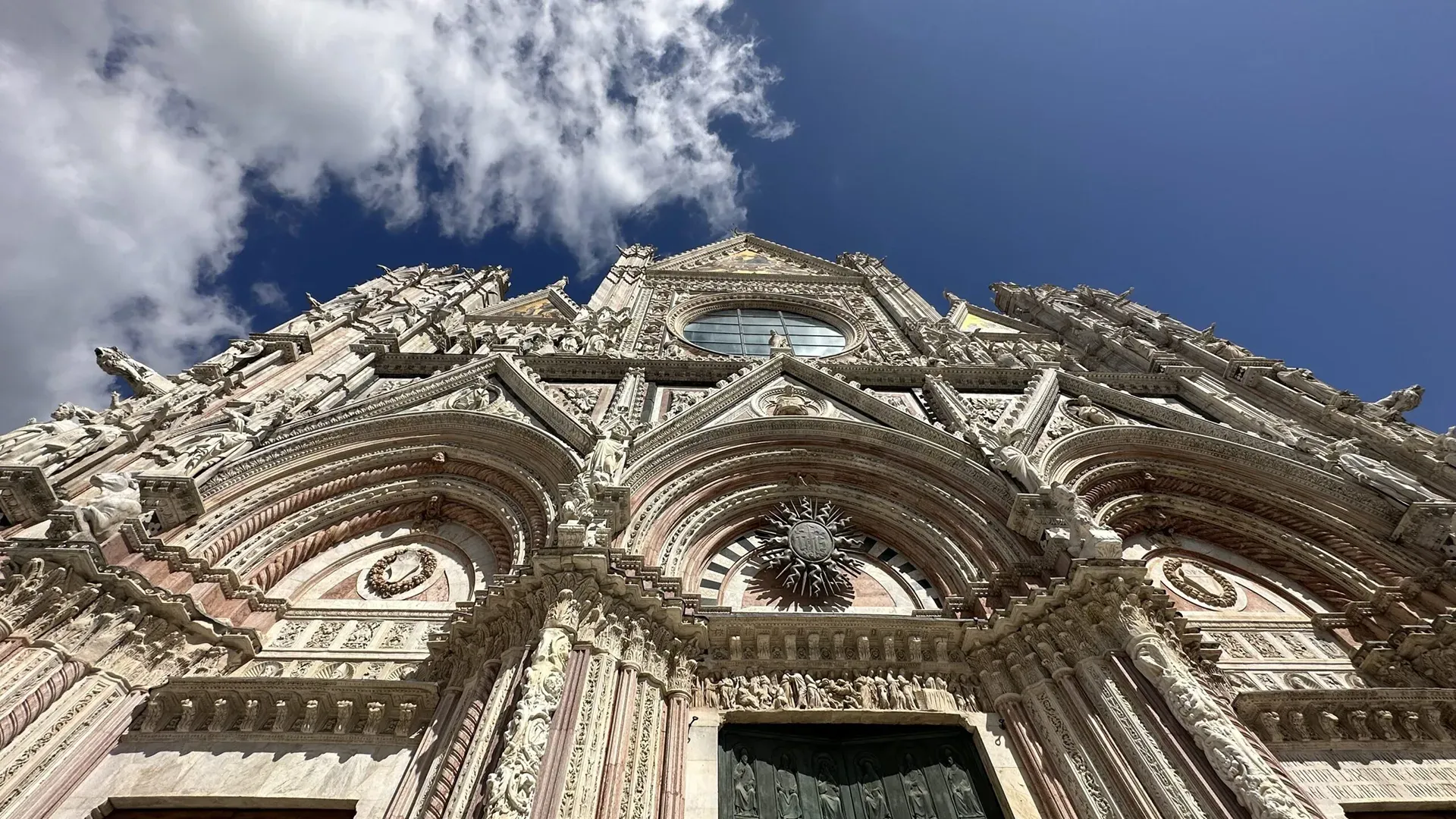
The cathedral itself is a 13th – 14th century architectural wonder, with the exterior captivating visitors with its multicolored marble facade, statues, gargoyles, detailed carvings, and stripes. The interior of the cathedral is equally impressive, with black-and-white striped pillars and ornate decoration on every surface.
Over the years, researchers have meticulously scrutinized the construction techniques and concepts of the cathedral, uncovering the building phases and the varied construction methods employed throughout its history. These techniques and the resulting architectural features, including the high vaulted ceilings, contribute to the cathedral’s status as one of the finest examples of Italian Gothic architecture.



Construction of the Duomo di Siena
The Siena Cathedral is one of Italy’s most illustrious Romanesque and Gothic cathedrals, and its construction involved several venerated names in art history, making it a significant landmark.
The construction of the Duomo di Siena began in 1226 and continued for about 175 years. The intricate façade was completed in two stages. This sounds like a remarkably short amount of time for such an impressive and intricate structure. Especially considering the construction techniques used in the day, employing hundreds if not thousands of masons and workers. Some of the tools used are on display in the attic. You can see then by taking the Porta di Cielo tour.
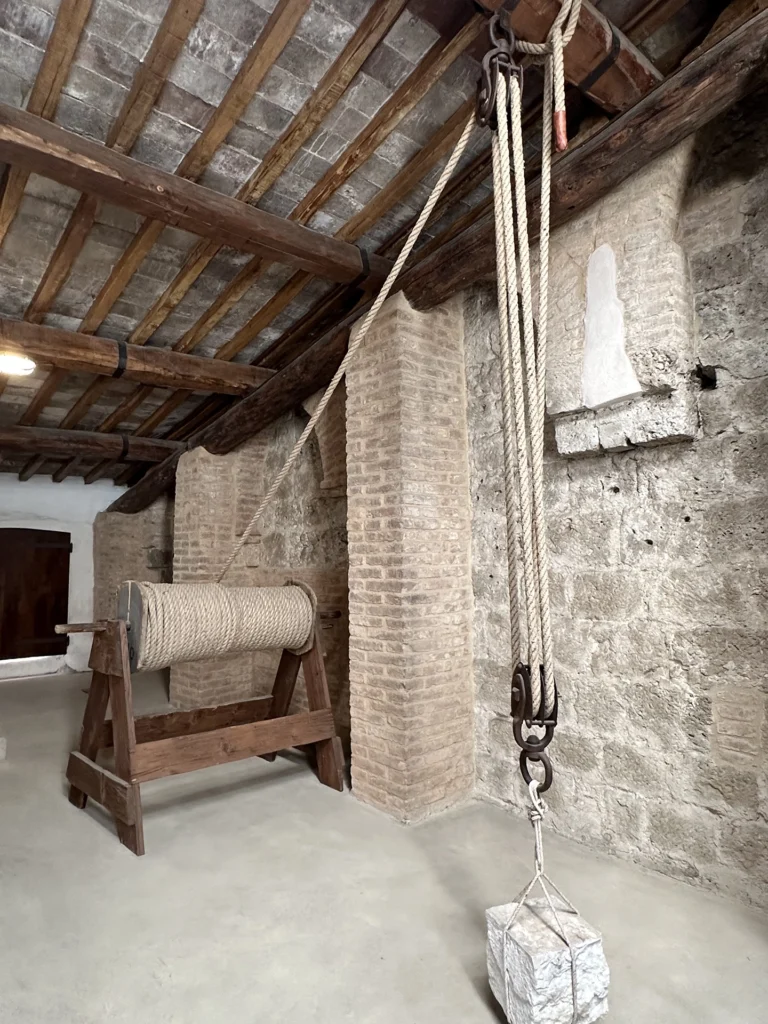
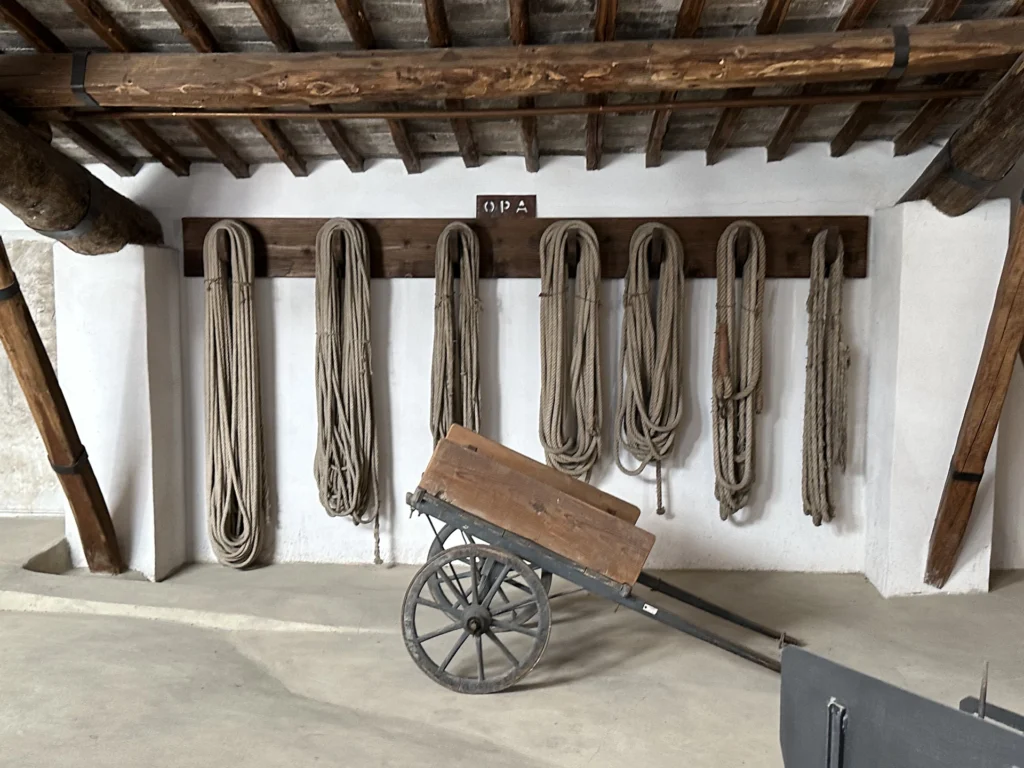

The cathedral itself is a 13th and 14th century architectural wonder, with the exterior captivating visitors with its multi-colored marble facade, statues, gargoyles, detailed carvings, etc. The interior of the cathedral is equally impressive, with black-and-white striped pillars and ornate decoration on every surface.
Key stages of construction of the Duomo di Siena
The construction of the Duomo di Siena took place in several stages. The main stages of its construction are as follows:
- The construction began in 1215 to replace the older Romanesque structure and was largely completed by 1263
- The lower façade was designed by Giovanni Pisano and completed by Camaino di Crescentino, with work on the west façade ending in 1317
- The upper façade was finished sometime between 1360 and 1370
- The raising of the vaulted ceiling occurred in the 14th century.
- Camaino di Crescentino oversaw the construction of the interior between 1317 and 1325.
- The exquisite inlaid floors were created over many decades, between 1369 and 1547
Work on the cathedral continued throughout the centuries and portions of the Duomo remain unfinished to this day. The most noteworthy is a planned nave extension that would have doubled the size of the cathedral.
The builders halted construction when the Black Death cut down four fifths of the population. Vestiges of the extension are still visible today and remain a symbol of Siena’s influence and ambition.
Black and White Marble Walls and Columns of the Duomo
One element that stands out is the use of black and white marble, though some of the literature describes it as greenish black. I personally did not notice the green hues. Color is to subjective.
Several sources mentioned that black and white are the symbolic colors of the city of Siena. They are associated with the black and white horses of the mythical founders of the city: Senius and Aschius.
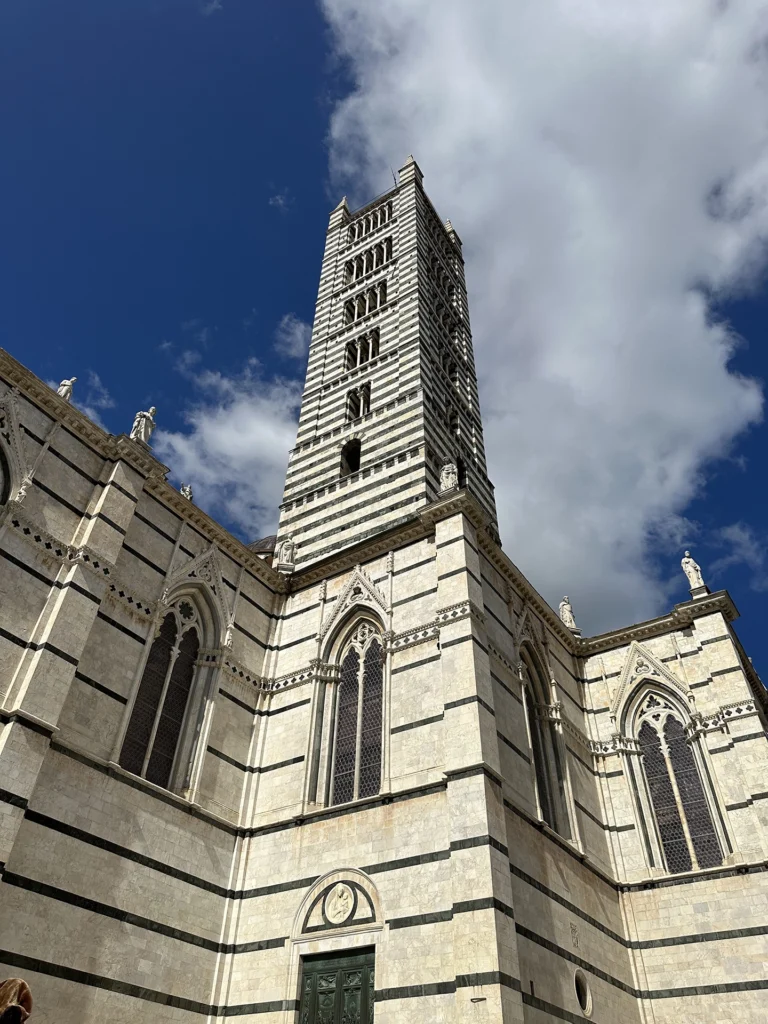
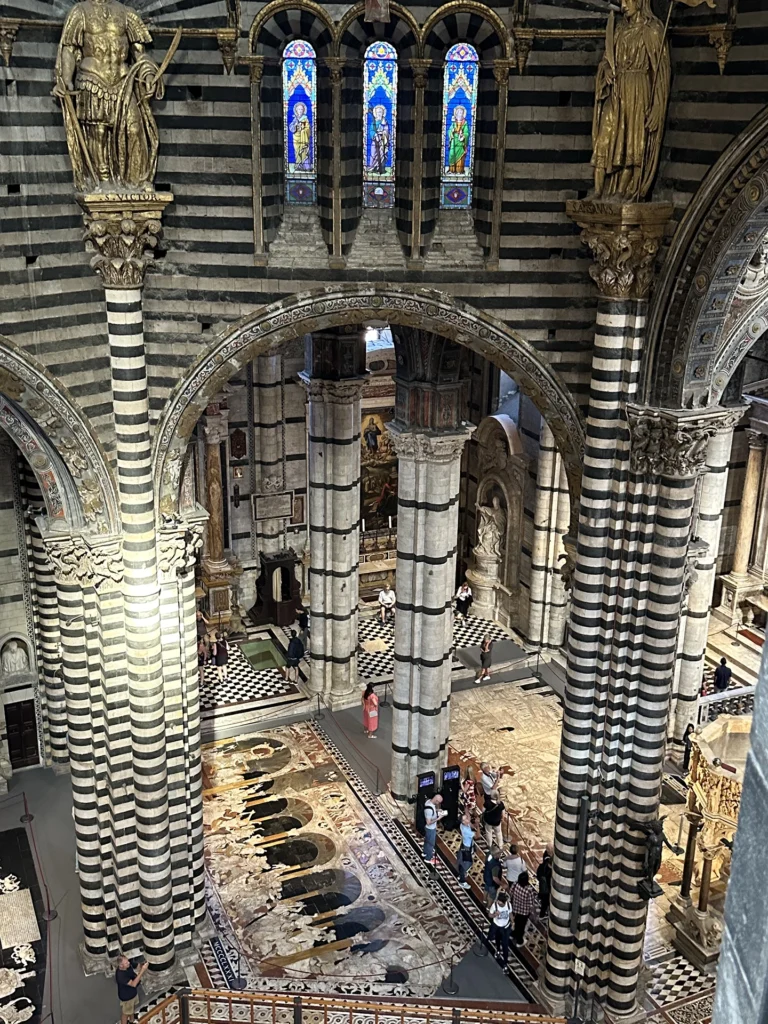
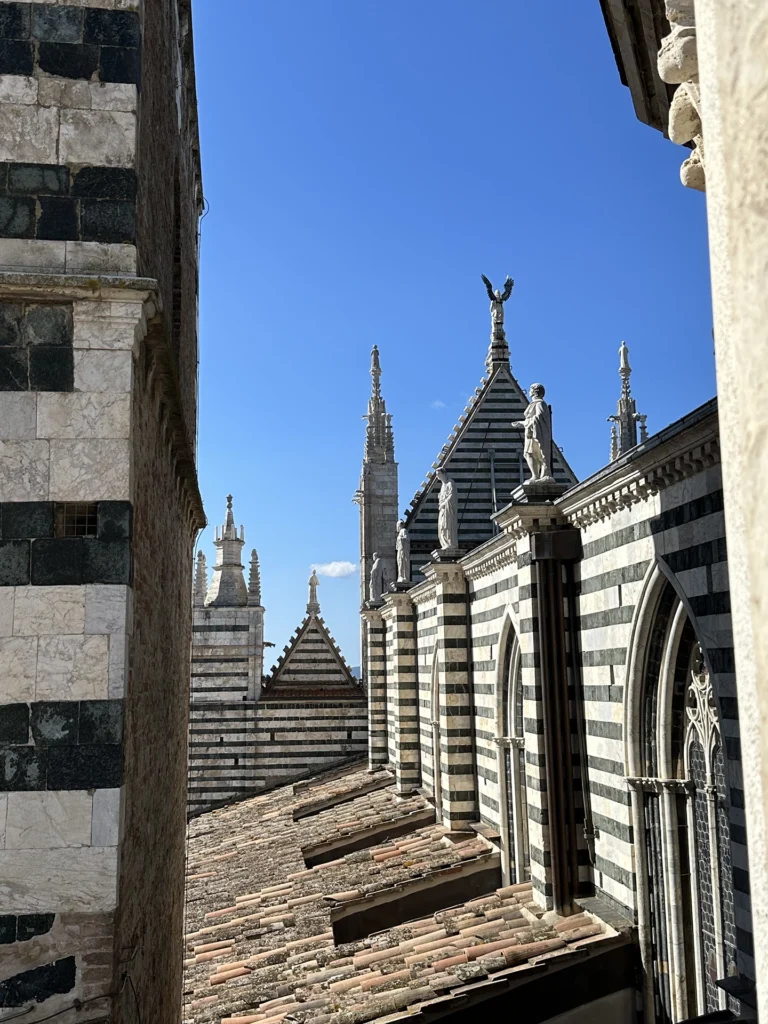
This may be true, but the alternating rows of Black and White marble are not unique to the Duomo di Siena. You’ll finds similar designs or variations on the theme at:
- Santa Maria del Fiore cathedral in Florence
- The Basilica di Santa Croce in Florence,
- The Cathedral of San Lorenzo in Genoa
- The Chiesa di San Giovanni Battista (1307) in Monterosso al Mare,
- The Chiesa di San Pietro in Coniglia (1334).
In fact, according to sources, it is a main feature of Ligurian Gothic architecture though the Duomo di Siena seems to predate many of these.
Other examples of this black and white motif are the cathedrals of:
- Ventimiglia and
- Albenga,
- San Siro in Sanremo,
- Santa Maria di Castello,
- San Donato,
- The sides of the cathedral of San Lorenzo in Genoa,
- The cathedral of Brugnato in the Spezzino,
- and San Pietro in Portovenere.
Exquisitely Inlaid Marble Floors – the Pride of the Duomo di Siena
One of the main features – though there are several – are the exquisite marble inlay and graffito floors. Described as “one of Siena’s most beautiful wonders” these remain hidden from view for most of the year to protect them from wear and tear. When on display, many are roped off to avoid damage from foot traffic. This is one of the many downsides of overtourism.
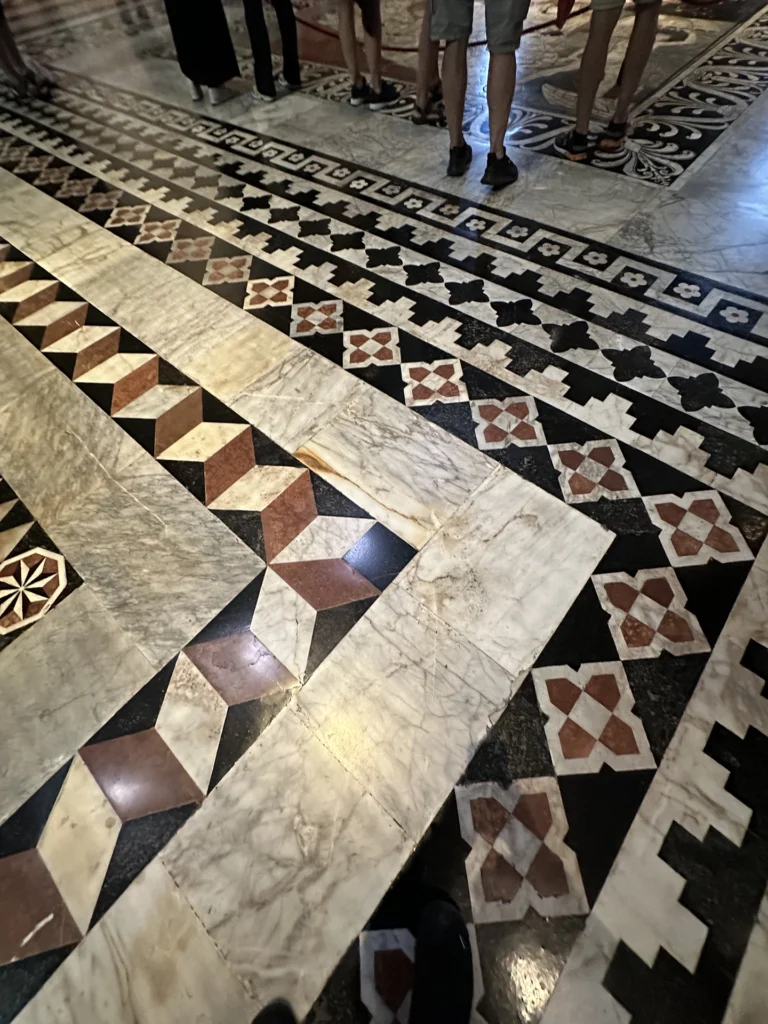
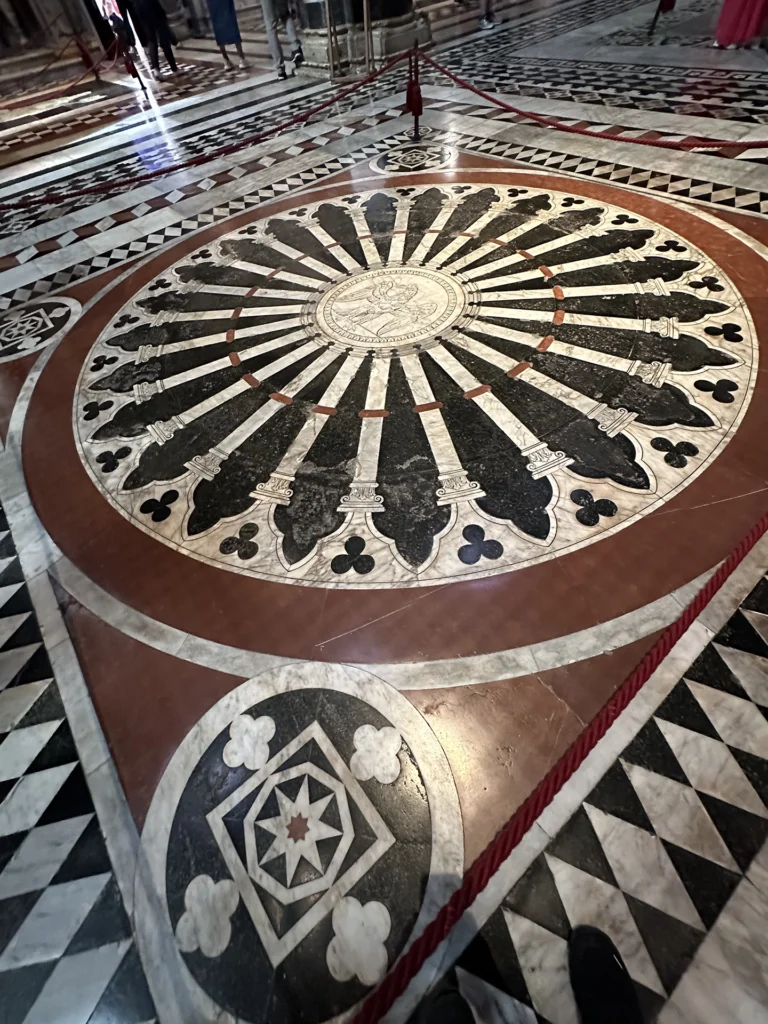
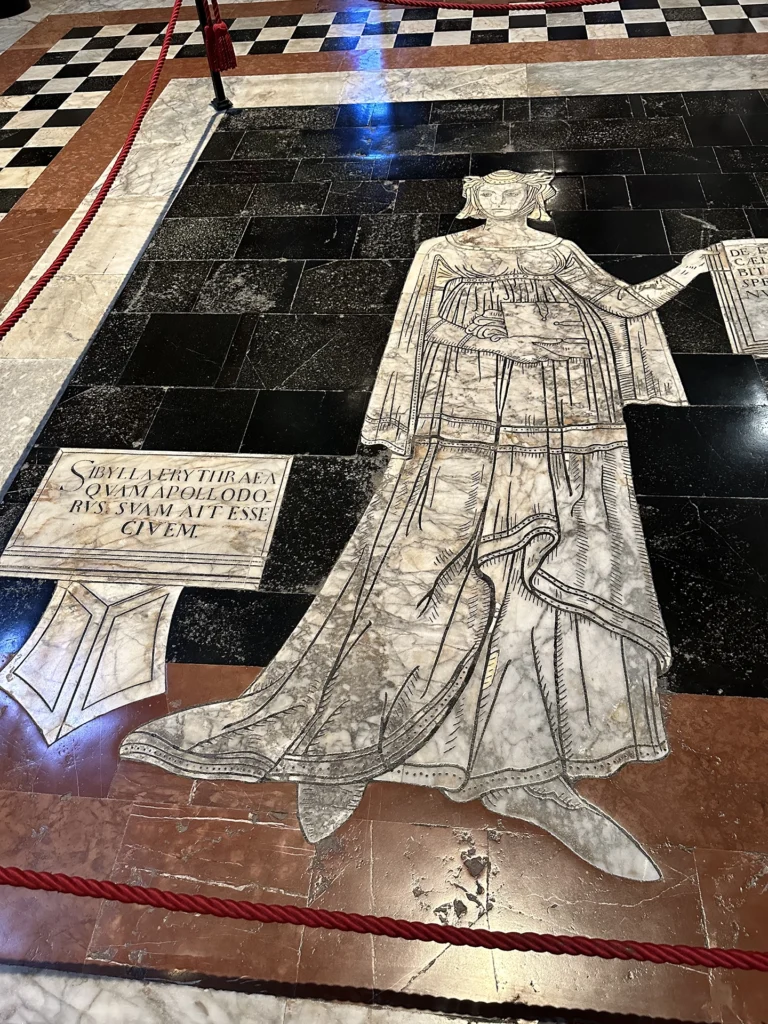



We were fortunate to be in Siena during the fall uncovering period that runs from late August to mid-October. I must say, they are stunning. Apparently, the floor contains 56 panels of different sizes. They were created by no less than 40 of the leading Sienese artist of the period between 1369 and 1547.
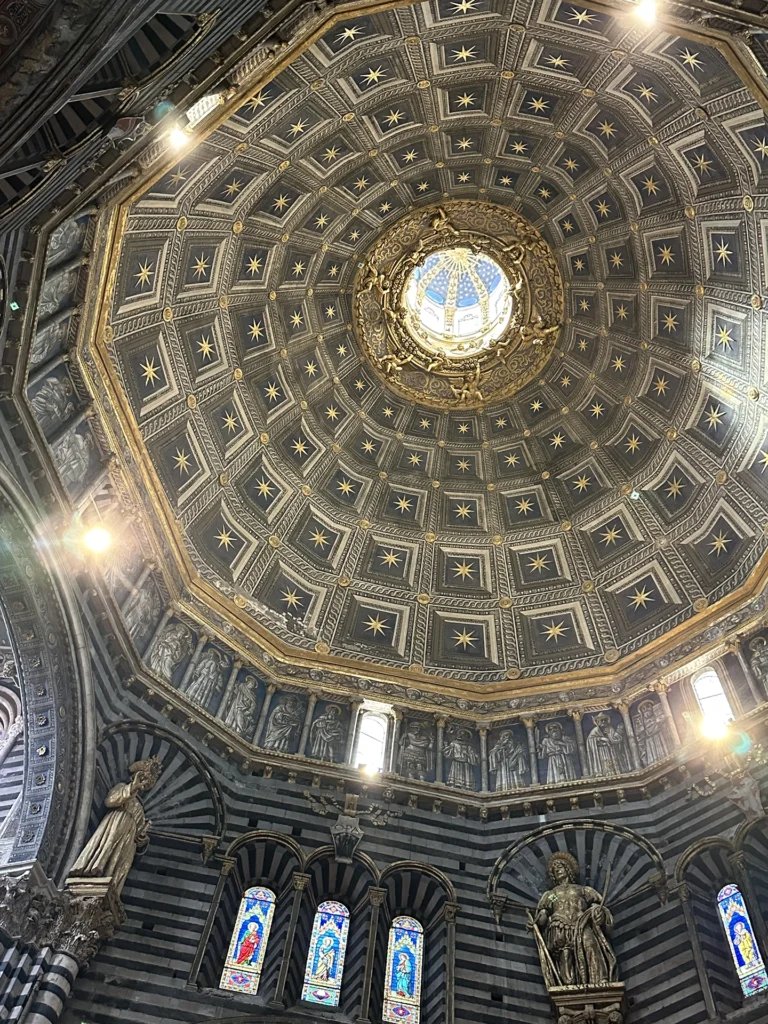
The Dome of the Duomo di Siena
The dome of the Duomo di Siena predates Brunelleschi’s famous dome in Florence. It rises from a hexagonal base with supporting columns and is adorned with a captivating ceiling painted in rich blue with gold stars.
The Brunelleschi dome, a prominent feature of the Florence skyline, is covered with frescos on the inside, not unlike the ceiling of the sistine chapel.
The interior of the dome is a remarkable example of the cathedral’s architectural and artistic significance. I find the dome design to be more grandiose and awe-inspiring. I can just imagine the sound of chanting priest echoing through the structure.
Siena Cathedral’s High Vaulted Ceilings are a Marvel to Behold
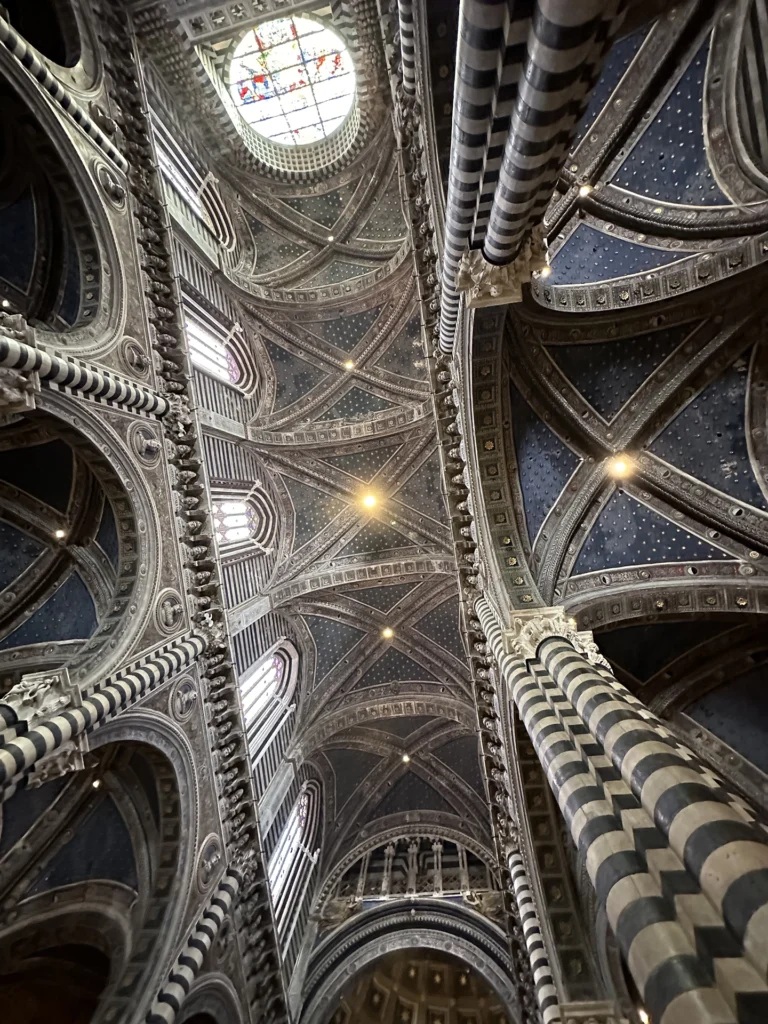
The high vaulted ceilings of the Duomo di Siena, are a significant feature of this architectural masterpiece and a wonder to behold. The vaulted roof is decorated in blue with golden stars which complements the interior of the dome. This design choice adds to the overall grandeur and aesthetic appeal of the cathedral’s interior.
I can only imagine how awestruck early parishioners of Siena much have been upon seeing the Cathedral’s interior for the first time. It’s hard not to believe that such a marvel is the product of a divine miracle.
Imagine: A raising of the vaulted ceiling occurred in the 14th century. This modification was part of a series of changes made to the original plan of the cathedral, including raising the façade due to the raising of the nave of the church. What a huge job!
The Magnificent Stained Glass Window of the Siena Duomo
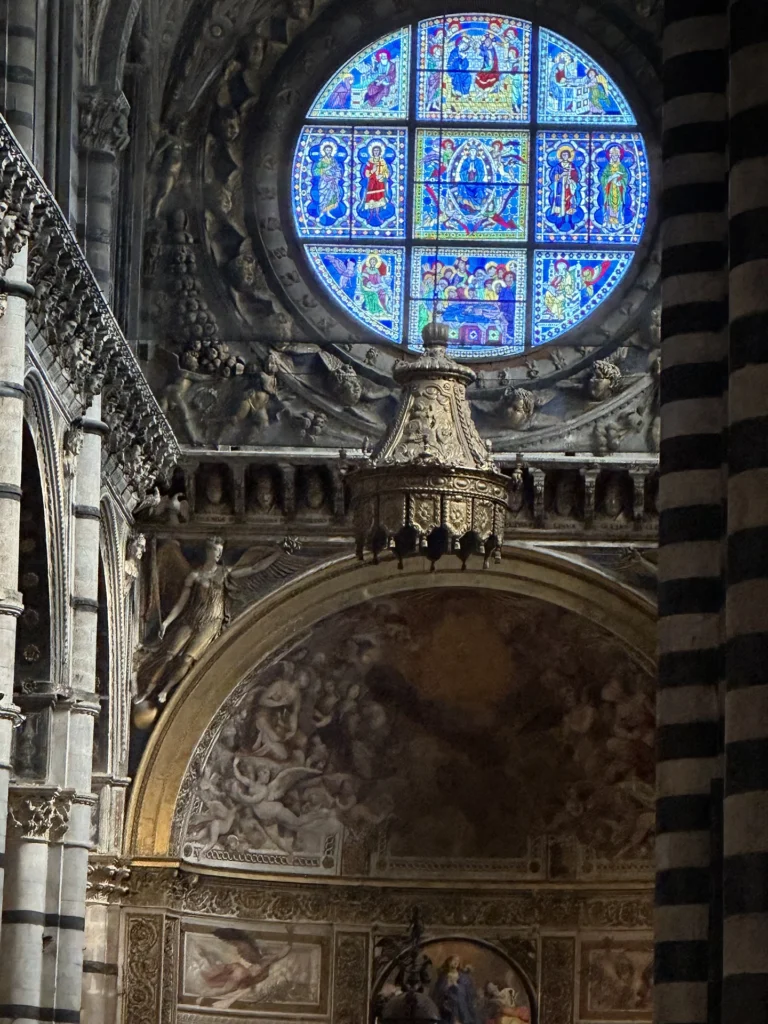
The stained glass windows in the Duomo di Siena are a very significant part of its artistic and historical heritage. What would a cathedral be without a stained glass window such as this.
One of the most notable stained glass works is the glorious rose window showing the Virgin, saints, and evangelists of the choir of Santa Maria Assunta. The Commune of Siena commissionned this monumental stained glass window, which is 6 meters in diameter, in 1287-88. It is the work of Duccio di Buoninsegna, a prominent Sienese painter of the era.
Apparently, this window is a rare example in Italy, where such windows are not as common as in northern Europe, and it adds to the splendor of the Siena Cathedral.
Works of Art on Display in the Siena Cathedral
The Siena Cathedral, or Duomo di Siena, is home to a remarkable collection of artworks, making it an extraordinary museum of Italian sculpture. These masterpieces alone are worth the visit.









Some of the notable works on display include:
- Duccio di Buoninsegna’s Maestà
- The Cathedral Choir by Fra Giovanni da Verona,
- The Piccolomini Altar by Michelangelo,
- The pulpit by Nicola Pisano,
- The Fall of Manna and Esther and Ahasuerus frescoes by Ventura Salimbeni.
The cathedral also houses statues, sculpted sarcophagi, paintings, and other treasures, all of which reflect the rich artistic heritage of Siena. The valuable pieces of art, including The Feast of Herod by Donatello and works by Bernini and the young Michelangelo, further contribute to the cathedral’s significance as a cultural and artistic landmark.
The Crypt of the Duomo di Siena
The crypt of the Siena Cathedral has an interesting history. It was unexpectedly discovered in 1999 during renovations, having been filled with debris in the 14th century and hidden for almost 700 years.
The space contains a well-preserved cycle of 13th-century frescoes, depicting scenes from the Old Testament, the life of Christ, and the Passion of Christ.
The frescoes are by Sienese artists active in the last quarter of the 13th century, including Guido da Siena, Dietisalvi di Speme, Guido di Graziano, and Rinaldo da Siena.
The discovery of the crypt provided crucial evidence of the birth and early development of the Sienese school of painting. It’s remarkable that the frescoes remain in relatively good condition after seven centuries of neglect.
The crypt is now open to the public, allowing visitors to admire these exceptional paintings and intact architecture.
The Piccolomini Library
The Piccolomini Library is located inside the Siena Cathedral and is described as a significant cultural landmark. It was built in 1492 by Cardinal Francesco Todeschini Piccolomini, who later became Pope Pius III, to honor his maternal uncle, Pope Pius II.
The library is a treasure trove of Renaissance art and a testament to the power and influence of the Piccolomini family, with its rich history and stunning representations of the life of Pope Pius II.
The library also houses rare illuminated manuscripts and codices. The space was intended to house Enea Silvio’s book collection hence the name of “library” . The ceiling is decorated in the “grotesque” style and contains allegorical figures, pastoral scenes, and marine thiasoi.* (I had to look it up…see below).
The video on the right attempts to capture some of the grandeur of the library. You can see the frescoed vaulted ceiling as well as the collection of illustrated books.
The library is a must-see for enthusiasts of art and history, and it offers a glimpse into the life of one of Siena’s most prominent families.
* The term “marine thiasos” or “marine thiasoi” refers to a group or band similar to the Dionysiac Thiasos, but with the chief god replaced by a sea deity, such as Poseidon or other sea deities. I’m not sure if this makes things any clearer.
Duomo Tickets, Passes and Wait Times
Pro tip
Plan on getting to the Duomo di Siena early in the morning at peak periods to avoid the long lineups. We were there the last week in September at 2 pm and had to wait in line in the sweltering heat to buy tickets for over half an hour. It would have been a smart move to buy online since there was a shorter line with almost instant access.
Because my wife Danielle walks with great difficulty and with a cane, the ticket area staff took her aside and gave here priority access. This happened frequently during our trip much to our delight. Overall we found that in Italy, there is a lot of respect for seniors in general and people with mobility issues in particular.
The OPA SI Pass
In my opinion, the best deal is the OPA SI pass, which is a combo ticket valid for three days. It gives access to the Duomo di Siena Cathedral, the Baptisteria, the Piccolomini Library, the Crypt, the Facciatone as well as the Museo dell’Opera del Duomo. The Facciatone is the huge façade of the unfinished nave of the Cathedral.
You can also add on a visit to the Porta di Cielo, a visit of the Cathedral from the roof. This is only available at specific times of the day, and you must reserve your spot in advance.
Author’s note:
A ton of research went into creating this post. There is a lot of fragmented information on the web from multiple sources. A lot is incomplete or contradictory. I used Perplexity to source, validate and classify the information. The sources of the data are shared below. This is a firsthand account of our visit to the Duomo di Siena. All photos are my own. Thanks to all the sources for their insights and expertise.
sources and citations
Sources:
[1] https://www.twopartsitaly.com/blog/2021/10/5/the-duomo-of-siena-a-masterpiece-from-floor-to-ceiling
[2] https://buffaloah.com/a/virtual/italy/siena/ext.html
[3] https://operaduomo.siena.it/en/floor/
[4] https://en.wikipedia.org/wiki/Siena_Cathedral
[5] https://www.sienatickets.com/siena-cathedral/about/
[6] https://www.researchgate.net/publication/352462990_The_Cathedrals_of_Pisa_Siena_and_Florence_A_Thorough_Inspection_of_the_Medieval_Construction_Techniques
[7] https://buffaloah.com/a/virtual/italy/siena/int.html
[8] https://www.dailyartmagazine.com/duomo-of-siena/
[9] https://www.routledge.com/The-Cathedrals-of-Pisa-Siena-and-Florence-A-Thorough-Inspection-of-the/Matracchi-Giorgi/p/book/9781032019208
[10] http://www.sienaonline.com/siena_duomo.html
[11] https://www.headout.com/blog/siena-cathedral/
[12] http://www.travelingintuscany.com/art/sienaduomo.htm
[13] https://operaduomo.siena.it/en/the-cathedral/
[14] https://www.archiseek.com/2009/1263-duomo-siena-italy/
[15] https://unsettledown.com/blog/siena-cathedral
[16] https://www.sgira.org/itarchrev5.htm
[17] https://www.sienatickets.com/siena-cathedral/interior-architecture/
Citations:
[1] http://www.travelingintuscany.com/art/sienaduomo.htm
[2] https://operaduomo.siena.it/en/the-cathedral/
[3] https://www.artrenewal.org/art-collections/siena-cathedral/266
[4] https://www.sienatickets.com/siena-cathedral/inside/
Citations:
[1] https://operaduomo.siena.it/en/crypt/
[2] https://www.gpsmycity.com/attractions/cripta-del-duomo-di-siena-(crypt-of-siena-cathedral)-29529.html
[3] https://www.italia.it/en/tuscany/siena/church-places-of-worship/crypt-of-the-duomo-di-siena
[4] https://en.wikipedia.org/wiki/Siena_Cathedral
[5] https://www.newliturgicalmovement.org/2020/12/the-cathedral-of-siena-part-7-crypt.html
